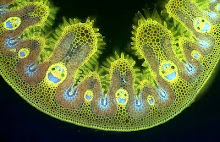Few seeds have such a pleasing shape as freshly shelled broad beans and I cannot think of another vegetable crop which has such fragrant flowers. I spent several years of my professional career working on the reproductive biology of this crop, alongside plant breeders who were trying to breed higher yielding, more stable varieties.
Part of the secret of high yields is effective pollination. The crop has a strange breeding system, where some of the plants are capable of self pollination (so-called autofertiles) and others (known as autosteriles) require cross pollination by bees. Cross pollinated plants produce offspring capable of self pollination and offspring of self pollinated plants are autosteriles that require bee pollination, so the proportion of each type, and therefore the number of plants that need bees to pollinate their flowers, varies between generations - leading to fluctuating yields in successive crops.
But always the key to a good yield is good pollination ...
......... and for that you need plenty of bumblebees, because honeybees aren't really robust enough to be effective pollinators.
The bumblebee needs to land on the keel petal and force it downwards to reach the pollen, and then extends its tongue to reach the nectar which is at the back of the corolla tube. As it does so ....
.... the stigma and stamens are released from the keel petals that envelope them and pollen is transferred to the bee and broad bean stigma, so .......
....... flowers that have been well and truly bumblebee pollinated look like this after the bee moves on. That requires quite a lot of effort on the part of the bee ...
.... but bumblebees are smart and some learn to be nectar thieves, biting a hole in the corolla tube and using their long tongues to extract the nectar without tripping the flower.
Vicia faba flowers are exquisitely fragrant and to stand in a field of them in full bloom on a summer morning is a memorable experience.
There is quite a lot of flower colour variation in this species, with pure white flowers in some varieties and - more rarely - plants with purple or yellow wing petal spots. There's also considerable variation in seed size, from the small-seeded paucijuga types that are grown in North Africa, through the larger seeded equina 'horse beans' (aka field beans) that are grown for animal feed, to the large-seeded broad bean types that are grown as a vegetable.
Plant breeders only have the genetic variation within the cultivated crop to work with - Vicia faba is a cultigen, an ancient crop of unknown origin with no known wild populations. What's more, it will not cross with related wild Vicia species, so the pool of genetic variabilty that plant breeders have to their disposal is strictly limited.
Image source: http://en.wikipedia.org/wiki/File:Illustration_Vicia_faba1.jpg




















